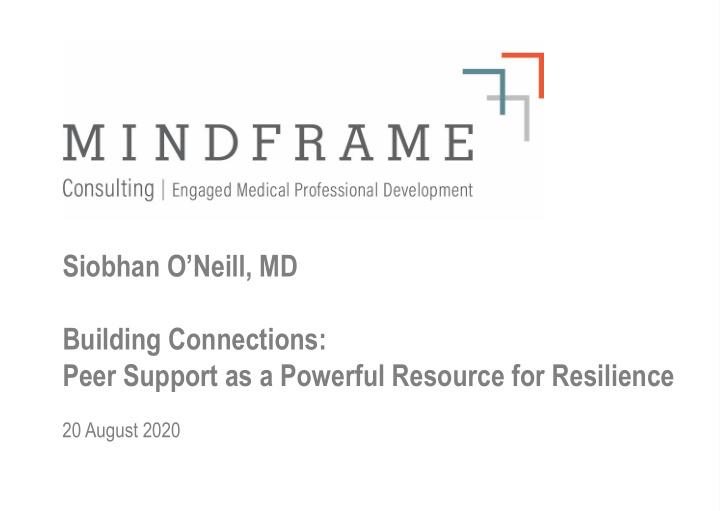



Siobhan O’Neill, MD Building Connections: Peer Support as a Powerful Resource for Resilience 20 August 2020
What is Resilience?
Poll 1: Resilience 1. Do you have a clear sense of what resilience is? – Yes – No – Not sure 2. Is resilience learnable or innate? – Learnable – Innate – Not sure
Resilience • Capacity to meet challenges • Adaptation and Flexibility • Ability to return to equilibrium quickly after stressful experience • Learnable
Dimensions of Resilience Physiologic Emotional Psychological Interpersonal: relationships Group/systemic
Why should we build resilience?
Wellbeing arises from Integration* • Flexible • Adaptive • Coherent • Energized • Stable Daniel Siegel; www.m.drdansiegel.com
Caregivers at Risk • Burnout and Distress – As high as 50% of physicians • Moral Injury in Healthcare – Reframing distress. Moral injury, not burnout. Locates source of distress in system rather than in the individual. – www.fixmoralinjury.org • COVID-19 is making moral injury worse
Poll 2: Stress 1. Have you experienced burnout or work related distress? – Yes – No – Not sure 2. Are you experiencing more work related stress since COVID-19? – Yes – No – Not sure
Caregivers at Risk • Substance Use Disorders • Depression • Anxiety • Isolation • Suicidality • Completed suicide: physicians >2x, nurses 1.25x rate of general population
How do we build resilience?
Multidimensional approach • Physiologic: sleep, exercise, nutrition, relationships, breathing & mindfulness practices • Emotional and psychological: practices that support healthy expression and regulation; education and psychotherapy; relationships, breathing & mindfulness practices • Interpersonal: building connections and nurturing relationships ; engaging supports; mindfulness practices
Mindfulness Breathing Relationships
Mindfulness “The awareness that arises from paying attention, on purpose, in the present moment and non- judgmentally” -Jon Kabat-Zinn
Mind Training Mind Training: focused attention, open awareness, kind intention. Cultivates receptive mind: Curious Open Accepting Loving -Daniel Siegel
Poll 3: Mindfulness 1. Do you have a regular (at least several days a week) mindfulness or mind training practice? – Yes – No
How do Breathing and Mindfulness foster resilience? Physiologic: parasympathetic predominance Psychological and emotional: Receptive mind rather than reactive mind Aware of and open to connection to others
Resonance Breathing • Purpose: to access and strengthen innate capacity of body to return to state of calm after a stressor (resilience) • Method: Paced breathing, inhale=exhale, 4-6 breaths per minute • Result: subjective sense of balance, calm, and wellbeing; improvement in biological measures of stress (increased HRV, lower BP, inflammatory markers)
Relationships Peer Support is directly related to interpersonal dimension of resilience: Engages these resilience traits: Mobilizing supports Close, secure attachment to others Collective/shared goals
Peer Support Multiple expressions: formal and informal -One to one -Groups -Teams
Poll 4: Peer support 1. Are you aware of what peer support resources are available in your institution? – Yes – No 2. Do you know how to access peer support resources? – Yes – No
Peer Support -Establish and maintain a trusting connection and nonjudgmental stance -Be fully present (receptive mind) -Listen attentively In other words: “… paying attention, on purpose, in the present moment and non-judgmentally”
Peer Support Peer Resource Groups Reduce isolation Increase connection Build cohesion Instill Hope Shift perspective: common humanity Practice altruism Yalom & Leszcz
Team Support The Honor Project Meaning-centered team intervention to give voice to grief through ritual Better coping, greater sense of meaning, reduced feeling of isolation R. Rossi https://doi.org/10.1093/neuonc/noy148.585
Practice: Three Good Things Cultivating positive emotions promotes the development of psychological resilience. 1. Reflect on/write down three good things that happened today- at least one good thing at work. 2. What was your role in making those things happen? 3. What positive emotions did you experience as a result? Joy, serenity, contentment, gratitude, compassion, interest, amusement, inspiration, awe, love. Presence and active listening on the part of the listeners: 1. full presence and attention 2. eye contact 3. No questions or discussion Greater Good in Action: ggia.berkeley.edu
Welcome back How was the breakout exercise? Please send your comments in the chat!
Building Connections Now more than ever, in this time when we need to maintain physical distance from one another, we need each other.
Siobhan O’Neill, MD mindframe.consulting
Resources referenced in this seminar Caplan A, Dean W, Talbot S. Clarifying the Language of Clinician Distress. JAMA. 2020;323(10):923-924: Moral injury in healthcare: www.fixmoralinjury.org Kabat-Zinn, Jon; Mindfulness Based Stress Reduction (MBSR): www.mindfulleader.org. “The most scientifically tested and well- established mindfulness training program.” Rossi, Rosemary; The Honor Project. https://doi.org/10.1093/neuonc/noy148.585. Team-based intervention to honor grief through ritual and peer support. Siegel, Daniel; Mind Training and Interpersonal Neurobiology; founder of Mindful Awareness Research Center UCLA: www.m.drdansiegel.com. Many resources to educate and support wellbeing. Steffen PR, Austin T, DeBarros A, Brown T. The Impact of Resonance Frequency Breathing on Measures of Heart Rate Variability, Blood Pressure, and Mood. Front Public Health. 2017;5:222. Published 2017 Aug 25. doi:10.3389/fpubh.2017.00222 Stern, Edwin; Resonance breathing: “The Breathing App” (Available in app stores). Breathing practice to build physiologic resilience. Three Good Things; Greater Good in Action: ggia.berkeley.edu. Exercise to foster positive emotion Additional resources Vivek Murthy's new book, published April 2020: Together; The Power of Human Connection in a Sometimes Lonely World https://www.gold-foundation.org/newsroom/news/dr-vivek-murthy-the-power-of-human-connection/ AMA Steps Forward CME series. Online training on professional wellbeing. https://edhub.ama-assn.org/steps-forward/module/2702556
Recommend
More recommend